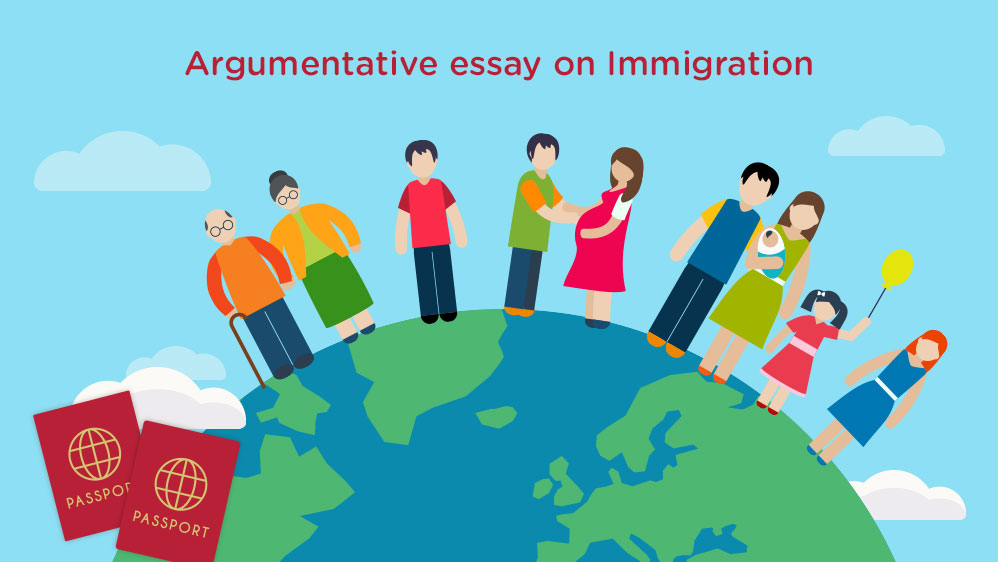Argumentative Essay on Immigration


There are a considerable number of reasons why individuals move to other nations. Some people are essentially compelled to move considering war and antagonistic vibe. It was the case with the Syrians a year ago and the Jews during the Nazi occupation. Others move since they want to find better work environments and openings for work abroad – the so-called greener pastures. A number of immigrants say that they abandoned their nation due to bias and abuse. Others relocate because they are looking for experience or simply need a better place to live and resign. Migration is a way of escape for the poor people. In fact, it is viable to work abroad, particularly when one does not see any change in his/her nation. A country loaded with brutality and defilement is not sound for any person. In such circumstances, it is smarter to escape and be an outsider.
Immigration is in many cases seen as a demonstration of mettle. Living abroad can be overwhelming for a newcomer since he winds up in another culture. He needs to get used to another style of living, maybe adapt to new convictions and a higher average cost for basic items. Indeed, the agony of abandoning your family is difficult to cope with. Additionally, foreigners confront more serious issues: underemployment and unemployment, not getting enough help from the legislature and being segregated by society since they are viewed as a major aspect of a minority gathering. There is likewise detachment nervousness and the challenge of finding a superior employment. All things considered, there should be a strong motivation behind why people migrate.
The History of Immigration in America
It has been said that population movement is as old as America itself. History of immigration in the US dates back nearly to the 1500s, the point at which the West confronted the happening to the Spanish. Around that time, the Americas had been settled by the Indians, who were soon undermined by the main outsiders of America. These Spanish heroes debilitated to undermine the way of life of the Indians. Clearly, movement began long ago but has everlastingly impacted America.
In 1880 and 1920, just about twenty-four million outsiders went to the United States. They left their countries for America for better compensations, religious flexibility, and an opportunity to improve everyday life. Due to neediness, no future, and different separation in their countries, the impetus to leave was expanding. Amid the mid-1800s and mid-1900s, the work and ranch turns in Eastern Europe were procuring around 15 to 30 daily. In America, they earned from 50 pennies to 1 dollar a day multiplying their compensation check.
The 3 Waves of Immigration in the US
In the 1500s, Europeans led by the French and Spanish have begun to build up America by making new settlements. In 1607, the English made their first permanent settlement known as Jamestown. First pioneers came to America to uninhibitedly hone their own religion. In 1620, 100 explorers fled Europe due to religious oppression and built up a province at Plymouth, Massachusetts. They were later trailed by an ale gathering of individuals known as the Puritans and settled close to the Massachusetts Bay. Near 1630 and 1640, around 20,000 puritans moved to America. Another group of settlers were compelled to America to wind up slaves. By 1680, there were around 7000 African slaves in American settlements, and this number increased to 7000,000 by 1790. Congress banned slavery in 1808, yet the ban was often ignored. The U.S Civil War at that time enabled the liberation of around 4 million slaves. Another real influx of immigrants happened in 1815-1865. Most of these settlers originated from Northern and Western Europe. Around 33% came from Ireland escaping from a monstrous starvation. In the 1840s, the portion of America’s outsiders came from Ireland alone. The majority of the Irish settled close to the east coast. Near 1820 and 1930, there were 4.5 million Irish and 5 million Germans in the U.S. They went to Midwest where they built farms. During the California dash for wealth, in the mid-1800s, around 25,000 Chinese came to America. Numerous outsiders go to America in search of occupations while others fled to the country for religious purposes. The U.S. experienced real melancholy because of the Civil War in the 1870s that decreased the influx of workers.
In 1880-1920, more than 20 million workers came to America. Foreigners in the 1890’s were generally from southern and eastern Europe. That decade alone, around 600,000 Italians relocated to America. By 1920, 4 million have migrated to America.
To escape religious abuse in Europe, Jews came to America in substantial numbers; more than 2 million Jews moved to the U.S. near 1880 and 1920. However, World War I (1914-1918) caused a noteworthy decrease in the movement. Congress enacted the law requiring the migrants who are older than 16 years of age to take an education test in 1917, and in the 1920s movement shares were put.
Impact of Immigration in the USA
Foreigners are at the bleeding edge of advancement and inventiveness in the United States representing a lopsidedly high offer of patent filings, science and innovation graduates, and senior positions at top investment financed firms. What is more, the nearness of foreigners frequently makes open doors for less-gifted local laborers to gain considerable authority in their work.
Migration for the most part additionally enhances the administration’s monetary circumstances; the same number of workers are paid more in charges over a lifetime than they expend in taxpayer-driven organizations. Therefore, local citizens of states with a lot of less-instructed migrants may confront bigger taxation rates as these workers pay less and will probably send kids to government-funded schools.
A prominent view is that foreigners are taking occupations from American residents. Although migrants increase the supply of workforce, they spend their wages on homes, nourishment, TVs, and assorted products and enterprises and grow local financial request.
Most observational investigations demonstrate long haul benefits for locals’ business and wages from migration, albeit a few examinations show that these additions come at the cost of misfortunes from lower wages and higher unemployment. Standard financial hypothesis suggests that while higher work supply from movement may at first discourage compensation, after some time firms increment venture to reestablish the measure of capital per specialist, which at that point reestablishes compensation. Consistent development of the capital-work proportion maintains specialists’ normal efficiency as well as normal wages. While development in the capital stock shields normal wages from falling, immigration may influence the relative wages of various sorts of laborers by changing their relative supplies.
Illegal Immigration
All through the history of the United States, immigration has been influencing our nation’s texture, which started hundreds of years ago. Illicit outsiders also raise certain concerns. Illegal immigration is when individuals enter a country without government authorization. Starting from 2008, the Center for Immigration Studies concluded that there are 11 million illicit workers in the US which is less than in 2007 (12.5 million individuals). Although, the Center for Immigration Studies data are altogether different from other evaluations that range from 7 to 20 million. According to the Pew Hispanic Center, as for March 2009, there are 11.1 million unlawful outsiders while in March 2007 there were 12 million.
The influx of illicit workers to the United States influences each level of government essentially. Even though the genuine impacts of unlawful movement are fervent, it remains the administration’s obligation to adjust the enormous measures of information and general sentiments keeping in mind the end goal. Nowadays, we see a huge discrepancy between the needs of immigrants and what the country considers constitutionally reasonable. Utilizing the issue of illegal immigration as our model, we can perceive how the national government and state governments are compelled to collaborate and at times encourage the achievement of approaches when settling moderately complex law issues.
According to the early American pioneers and the developers of the Constitution, the United States were to speak to the beliefs of acknowledgment and resilience to those of different backgrounds. When the movement started in the mid-1800s, America ended up being everything except for that. People should understand the significance of hardships and dismissal faced by newcomers as they endeavor to assimilate in the American culture. For incalculable migrants, the battle to touch base in America is equal to the battle for the acknowledgment among the current American population.